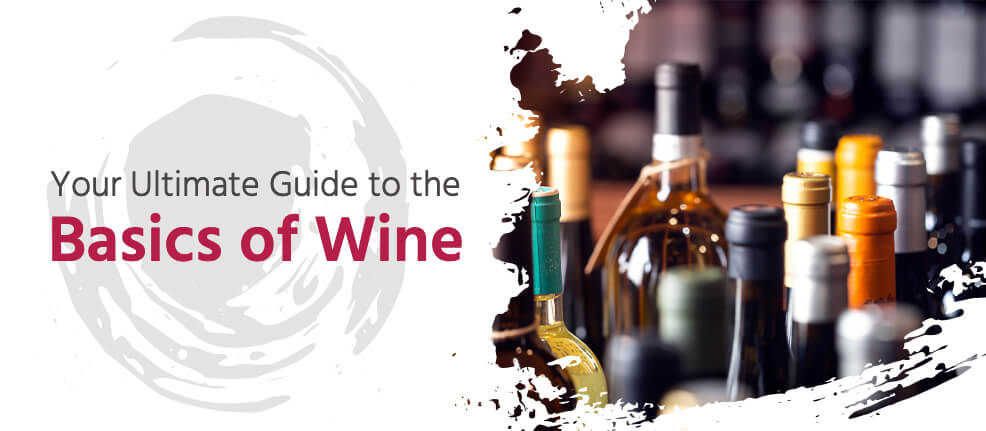
If you’ve spent time on social media lately or have gone out with friends, wine has probably been a popular topic.
With a rise in wineries in the United States — around 5% annually according to WineBusiness.com —sharing and talking about wine online, visiting wineries, enjoying wine-centered events and building memories that include wine have all become wildly popular pastimes.
Perhaps you enjoy a glass here and there but you’re not quite sure how to decipher your actual taste in wine. Or maybe you’re unsure about how to make a purchase. What does “vintage” mean, anyway? What’s a table wine? How does a wine’s “aroma” affect your taste for it?
We believe wine is something worth celebrating. You can enjoy it regularly or on special occasions — whatever suits your mood. But we also believe that to truly enjoy wine, and to gain some confidence in the meantime, a little education can go a long way.
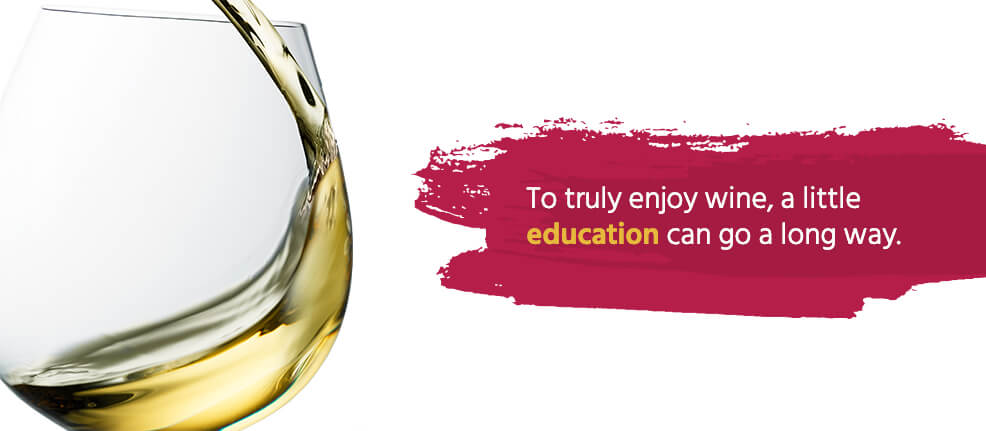
Consider this your beginner’s guide to wine. As you continue, you’ll learn more about wine and its history, how to taste wine, terms that might help you better understand what differentiates one bottle from another and everything else you need to start to learn about wine and what makes it so enjoyable.
Basic Wine Information for Beginners: What Is Wine in the First Place? Is It Healthy?
At a basic level, wine is an alcoholic beverage that’s made from fermented grape juice and/or other fruit juices. This is similar to how other alcoholic beverages are created. Beer is made from the fermenting of grains, vodka can be made from the fermenting of grains or potatoes, and so on. Wine is made from a similar process, but it involves fruit instead. If the fruit involved is not a grape, the bottle should be labeled accordingly.
Chemically speaking, wine is comprised of approximately 87.7% water, 11% alcohol, 1% acid and .2% tannins. This ratio can vary from one variety to another, but it provides a basic look at what’s inside a given bottle. Each bottle holds about five five-ounce glasses of wine.
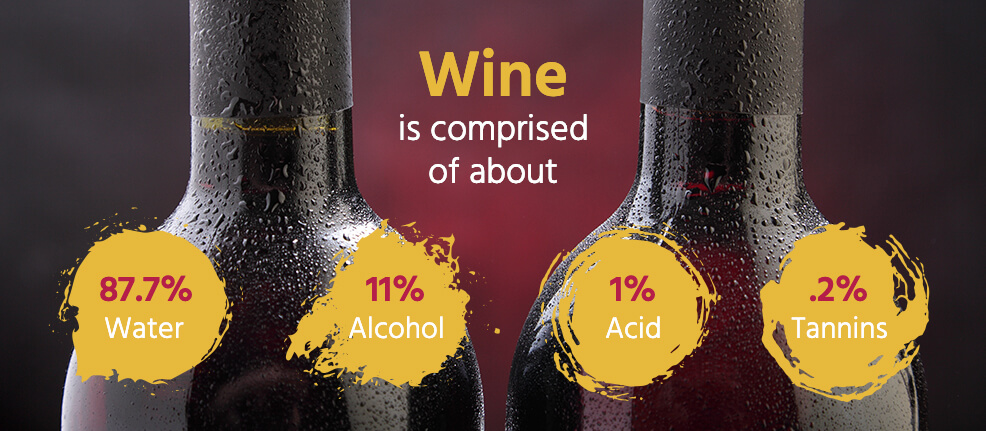
As far as health is concerned, you’ve likely heard it all, with some sources claiming wine is as healthy as going to the gym. While this may be a stretch, there are some qualities of wine that could influence your health for the better. Christian Nordqvist, in “Wine: Health Benefits and Health Risks,” provides some interesting health-related properties of wine:
- A lower risk of dementia. Among moderate wine drinkers, the risk of dementia is 23% lower than for non-wine drinkers.
- A lower risk of breast cancer. This excludes the drinking of red wine, which can increase the risk.
- Anti-aging properties.
- Lower risk of colon cancer. Moderate wine consumption can lower this risk by 50% according to some studies.
- Reduced depression rates.
- Higher levels of healthy omega-3 fatty acids.
It’s important to note that research changes regularly and that each of the above benefits is linked with moderate wine consumption, which for many individuals constitutes one 250ml glass per day. Over-consuming wine has been linked with negative effects — so moderation is key.
Wine Drinking Statistics
While the jury may be out on the health benefits of wine, one thing is for sure: it’s worth enjoying! If you like to have a glass of wine from time to time, you’re definitely not alone. This is made clear by the following facts and statistics, starting with a brief history of wine drinking.
People have been drinking wine for centuries. However, in an illustrated history of the drink, VinePair divulges that the first winery was established in Armenia around 4100 B.C. As time progressed, the practice of fermenting grapes spread to Egypt around 3000 B.C., where the drink was used for ceremonial purposes.
As Egyptians came into contact with the Jewish people and Phoenicians, wine spread via these avenues as well, eventually traveling across Mediterranean by trade routes by 1700 B.C. Eventually, the entire world found itself familiar with the joys of drinking wine.
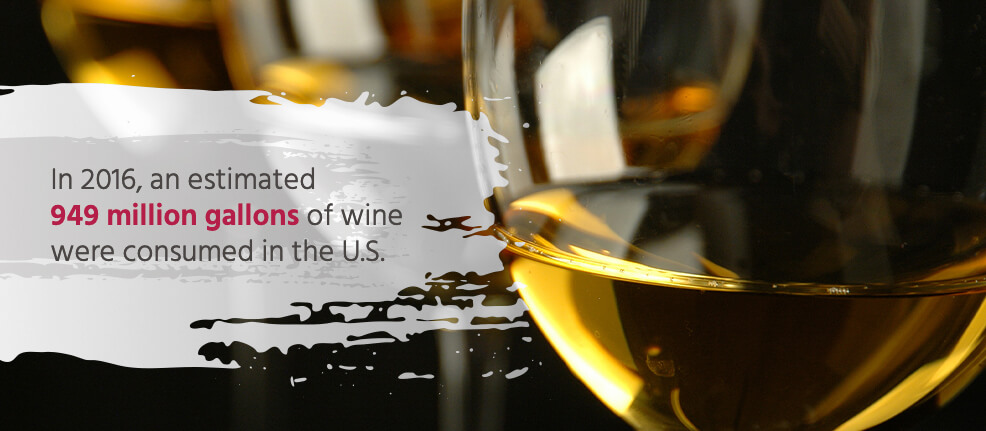
Indeed, wine knows no cultural limits and is enjoyed across the world. The Wine Institute recently released figures demonstrating just how popular the drink has become:
- In the U.S., an estimated 949 million gallons of wine were consumed in 2016. This equals out to around 2.94 gallons per adult.
- In terms of total wine consumption, the US remains the biggest wine market in the world.
- Among “high-frequency wine drinkers,” Chardonnay, Merlot and White Zinfandel are the most popular types.
- Among adults in general, fruity wines tend to be the most popular.
While everyone has a favorite or has room to develop one, it’s a certainty that the enjoyment of wine will continue to grow as time goes on.
Grapes, Grapes and More Grapes!
Not all grapes are created equally — especially where wines are concerned. Various wine varieties are differentiated by the grapes they are made from. This means that developing a basic understanding of the grapes that make wine is important before moving forward.
The grapes you see at the grocery store are probably not used to produce your favorite wines. While it is possible to buy wine grapes on their own, they’re generally not made for straightforward consumption. Whereas table grapes are grown to be physically appealing and easy to eat — with more fruit on the inside and thin skin on the outside — wine grapes are meant to make better wine. This means they have thicker skins, higher amounts of juice and more seeds. They’re also smaller than standard table grapes and contain sweeter juices thanks to a higher sugar content.
You may be able to identify which grapes are being grown in local vineyards by looking at the growing style. Wine grapes grow on high trellises to increase sunlight exposure and to produce a higher concentration of grapes than those grown for eating.
Wine Enthusiast identifies the five most popular wine grapes in the world as: Chardonnay, Cabernet Sauvignon, Sauvignon Blanc, Pinot Noir and Merlot.
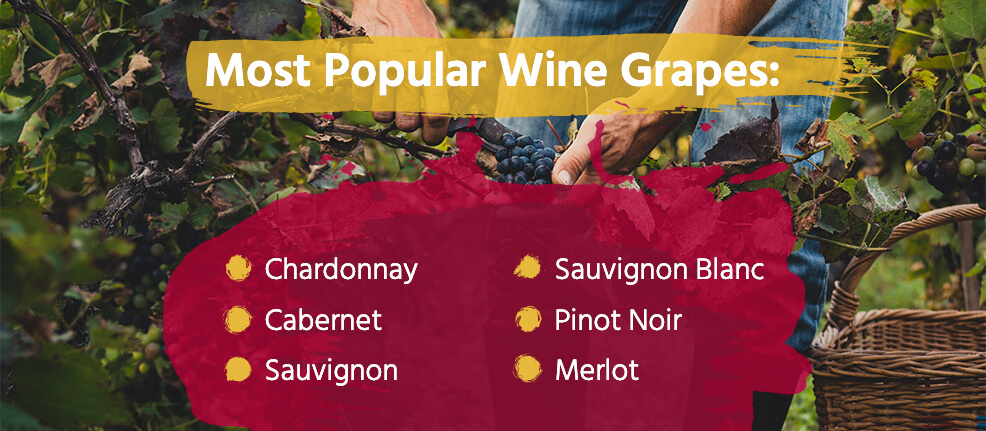
Chardonnay is widely popular due to the ease with which it can be grown. Because it ages well in oak or on its own, with a distinct yet varied flavor depending on the amount of residual sugar left in the wine and the region in which it grows, the grape lends itself to multiple tastes and palates. Don’t write off all Chardonnays after tasting just one!
Cabernet Sauvignon stands alone but is also popular in blends. It’s widely popular in the United States because of the optimal growing conditions found in California. The wines produced from the grape are generally known for deep, rich flavors and higher alcohol contents.
Sauvignon Blanc grapes grow around the world, from the United States to France and even distant New Zealand. Each country produces wines with distinct flavors, all stemming from the same variety of grape. The grapes lend themselves well to white wines, which accompany spicy foods rather nicely.
Pinot Noir grapes are difficult to grow but are extremely popular. The wines produced from Pinot Noir grapes are especially well-known in Burgundy, where bottles can retail for high prices attributable to the high quality and demand. Pinot Noir wines are generally bottled on their own without other grapes blended in and are known for a light to medium red wine flavor.
Merlot grapes are widely grown in New York and Washington but are also popular in Italy and South America. Merlot wines have a distinctive taste that tends to be more earthy than other reds, but is also balanced and mild compared to richer varieties like Cabernet Sauvignon.
These are just a few descriptions of the most common grapes you’re likely to find on wine labels. Finding your favorite among these may be a great first step. It might also help you identify similar wines that you may find enjoyable.
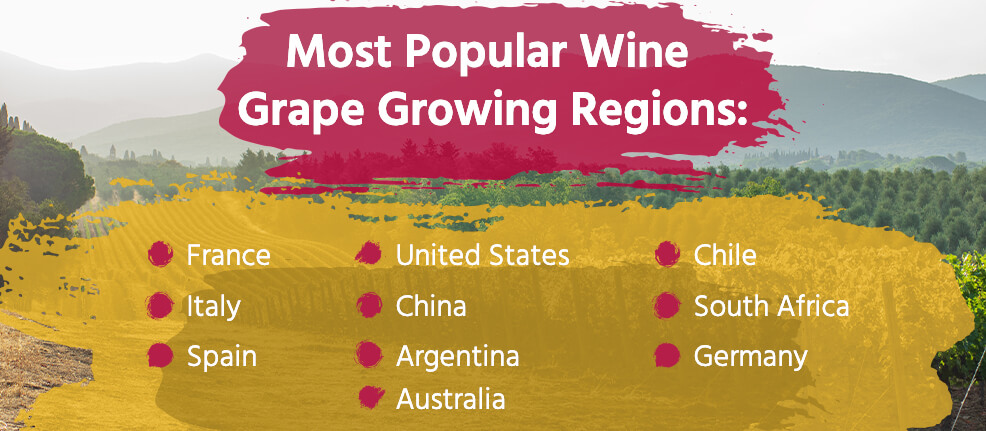
It’s important to note that various regions produce distinct wines based on the grapes they’re able to grow. If you find a wine you enjoy from a specific country, you may enjoy others from the same area. According to International Business Times, the most popular wine grape growing regions are:
- France
- Italy
- Spain
- United States
- China
- Argentina
- Australia
- Chile
- South Africa
- Germany
Red Wine? White Wine? Rose? What’s the Difference?
You may identify — or have friends who identify — as strictly red or white wine drinkers. But understanding what separates one from the other, could be helpful. It’s easy to look at a glass of wine and determine whether it’s red or white, but what’s the real difference?
Red wines are made from red grapes. But more importantly, the grape skins are left on during the fermentation process. This provides an obvious color difference and the presence of tannins. Tannins are naturally found in the skins of many fruits, including grapes. Tannins are a central feature in red wines, providing a level of complexity that’s difficult to accomplish in white wines. When a wine is described as “earthy,” it likely contains a high level of tannins.
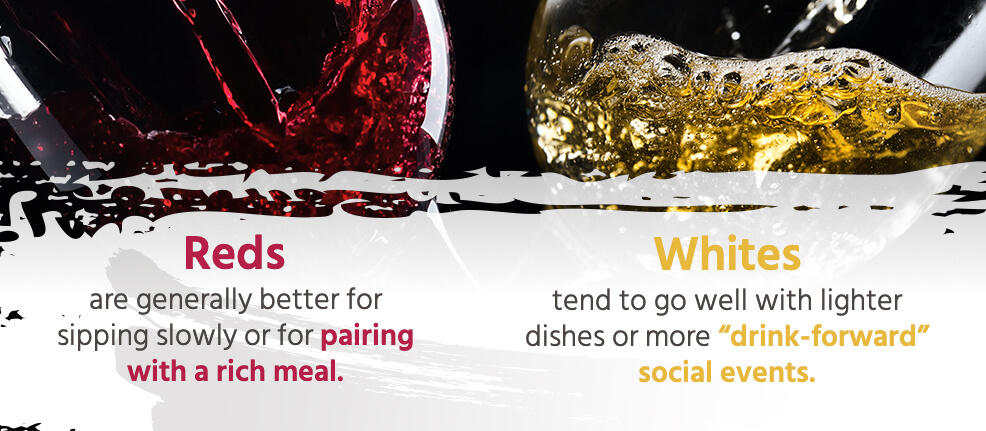
While white wines are typically made from white grapes, they can also be made from red-skinned grapes. Because the skins get removed from the grapes prior to processing, the wines remain white and free of the aforementioned tannins, making them lighter and less “full-bodied” in many cases. White wines are often described by their acidity levels and balances, which tend to be more pronounced than in reds.
Rose wines can be made from blends of red and white grapes or from red grapes from which the skins are removed early in the fermentation process. This allows for some of the color to remain but results in a lighter flavor with fewer tannins. Just like reds and whites, rose wines can be slightly sweeter or stark dry and can come from a variety of grapes.
When searching for the right wine, first consider its purpose. Reds are generally better for sipping slowly or for pairing with a rich meal, whereas whites tend to go well with lighter dishes or more “drink-forward” social events.
Wine Terms and Facts to Learn
Consider the following terms a general glossary of what you may encounter on labels and during your explorations of the world of wine:
- Acidity: Acidity balances out “sweetness” in wine. If a wine tastes tart or bitter, it may have a higher acid content, which is desirable for certain tastes.
- Alcohol Level: On average, especially in the U.S., wines contain an alcohol content of 11.5 to 13.5 percent.
- Aroma: The “smell” of a wine, which may be pleasant or less pleasant depending on individual preferences.
- Balance: A balanced wine means all the components work together well without anything “standing out.” Generally, balanced wines are more appealing than unbalanced wines.
- Blend: A wine blend is comprised of multiple grapes. In blends, the bottle may describe what grapes have been included.
- Corked: A negative term that describes a bottle of wine in which the cork has become too dry, allowing too much air to come into contact with the wine. Corked bottles of wine have distinctly negative flavors.
- Dessert Wine: Dessert wines are typically sweeter wines meant to be enjoyed following dinner.
- Dry: By definition, a dry wine contains no residual sugar. It has been fully fermented until no sugar remains.
- Fortified: A wine has been fortified if a non-wine alcoholic beverage has been added to it. Brandy is the most popular option.
- Ice Wines: Ice wine is produced when grapes are frozen during the fermentation process. In traditional ice wines, the grapes are frozen on the vine. However, some wineries simply freeze grapes after harvesting. Ice wines require more grapes for production, leading to higher purchase prices.
- Oaked vs. Non-Oaked: Oaked wines are aged in oak barrels, whereas non-oaked wines typically age in steel barrels. Oak barrels provide a distinct flavor that’s appealing to certain wine enthusiasts.
- Reserve: Reserve wine has typically been aged by the winemaker before sale. The term comes from the fact that certain bottles are “reserved” for some time prior to sale.
- Residual Sugar: When fermentation is complete, the amount of sugar left is referred to as the “residual.” In sweeter wines, the process is halted so more sugar remains, whereas dry wines are left to ferment until there is no residual sugar.
- Table Wine: The term “table wine” is broad and refers to most wines with an alcohol content under 14%, according to U.S. standards.
- Tannins: Tannins occur naturally as compounds in trees and fruits — and especially in grape skins. They provide a distinct, earthy flavor that can only be found in red and rose wine varieties.
- Varietal: A varietal wine contains a single grape variety, as opposed to a blend.
- Vintage: A wine’s vintage refers to the year the grapes used to create the wine were harvested.
The Importance of Tasting: Learn About Wine and Find Your Favorites the “Right” Way
When visiting a winery or a wine store, it’s important to taste various wines to learn more about your own flavor preferences. This helps in developing a better sense of what labels and descriptions will be more appealing to you than others.
You’re welcome to simply take a sip of a few varieties, but you might learn more by tasting wines using the following tactics.
First, try to block out any distractions. This can be difficult, but remember that tasting during a limo wine tour with many friends might not be as productive as going with a smaller group to a quieter location. Both can be enjoyable, however.
Because color and appearance are part of any good tasting experience, take the time to look at the wine. Swirl it a bit and look at how it adheres to the glass. A richer wine with a higher alcohol content may leave more of a “residue” or “leg” than a lighter wine.
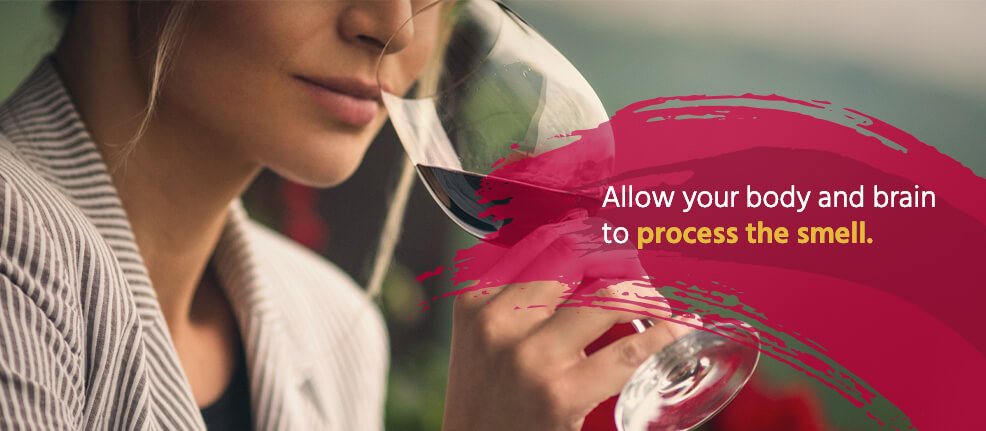
Next, give the glass a light sniff. Allow your body and brain to process the smell, which may help you anticipate the flavors you’re likely to encounter during the taste itself. Using all of your senses leads to a more successful wine tasting experience.
After you’ve given yourself time to process the scent of the wine, take a small sip and pull in a little air with it. Think about the way the wine sits on your tongue, including whether the flavor is something you enjoy or something you’d rather pass on in the future. Try to evaluate whether the wine feels “sour” — this could mean it has a higher acidity level — or “earthy,” which could indicate higher levels of tannins. Also, look for hints of flowery or “floral” tastes, citrus and other flavors that stand out. Think about what you find pleasant and what you don’t like. Then, follow up with the remainder of the glass.
Take notes throughout your tasting and don’t hesitate to try a wine a second time. More familiarity with a given wine might make you more confident in a purchase decision. As a best practice, save your wine tasting notes each time you partake and look back from time to time. You might find patterns that help you identify your favorites.
As you progress in your wine journey, be open to new tastes and recognize that certain flavors might sit better with you than others. Whatever you do, don’t limit yourself and have fun!
How to Store and Serve Wine
There are many misconceptions relating to wine storage and aging. It’s tempting to believe wines should be stored for a long time before opening because that’s what we tend to see on television.
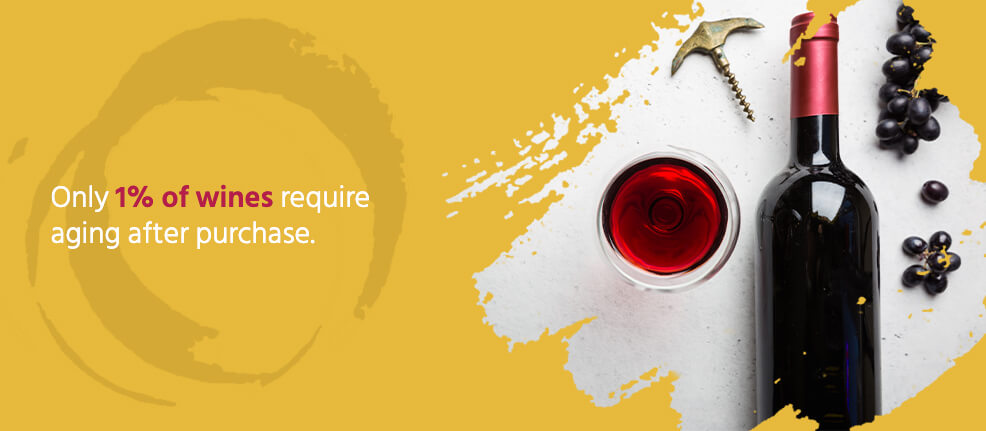
According to VinePair, only 1% of wines require aging after purchase. Instead, a majority of the wines available today are meant to be consumed within five years. If someone brings you a great bottle of wine, why not open it and enjoy?
To preserve the integrity of your wine, remember three key words: “dark,” “cool” and “sideways.”
Light can prematurely age wine, which is unfortunate if you enjoyed it during the tasting process. This is one reason wines are traditionally stored underground. If you plan to store wine in your home, find a place with little or no exposure to sunlight and other artificial light. Dark is best.
Cool is not the same as cold. Wines that are too warm or too cold can lose their flavor or pick up less desirable flavors over time. Try to find a location that maintains a steady temperature as close to 55 degrees Fahrenheit as possible. If the temperature changes too frequently, the wine may expand and contract, causing undesirable interactions with the cork that can allow excess air into the bottle.
Wine shelves are built sideways for a reason. If a cork becomes too dry, it can allow extra air into the bottle, which can ruin a bottle quickly. If you’ve tasted a bottle of wine that has been “corked,” you’ll know right away. A sideways position keeps liquid up against the cork to prevent this.
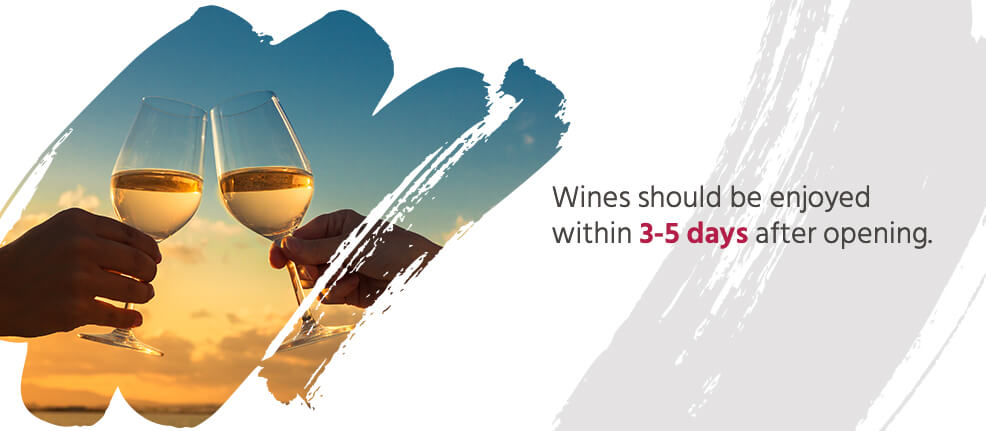
Once you’ve opened a bottle of wine, enjoy as soon as possible. As a general rule, wines should be enjoyed within three to five days of opening. Whites should be stored in the refrigerator with a cork or bottle topper. Reds should be stored in a cool and dark location, also with a cork or bottle topper. Boxed wine is designed to last longer — up to a month after opening — due to the closure mechanism.
Additionally, sweet wines may have a slightly longer shelf life after opening than traditional bottles.
Go Out and Enjoy Your Wine the Way It’s Meant to Be Enjoyed
Congratulations! If you read through this entire guide, consider yourself a proud graduate of Wine 101!
We believe the best way to gain confidence as you move forward in your love of wine is to learn as much as possible. Over time, you’ll learn more about what you enjoy and what you’d rather pass on. We trust that by understanding a few basics, you’ll be better prepared to not only purchase wine but also decipher labels, take part in conversations with long-time wine lovers and add a little extra enjoyment in celebrations that include wine.
Want to know what wine to have for an upcoming special occasion or even just for pairing with your next meal? Take our wine pairing quiz and find the perfect wine pairing!
Want to learn more? We’d like to invite you to stop by our Rochester, New York store to browse our large selection and experience our customer service firsthand. Not local? That’s great, too! Visit our online wine catalog to shop from the comfort of home. Be sure to watch for selections that include free shipping and multi-bottle discounts.
